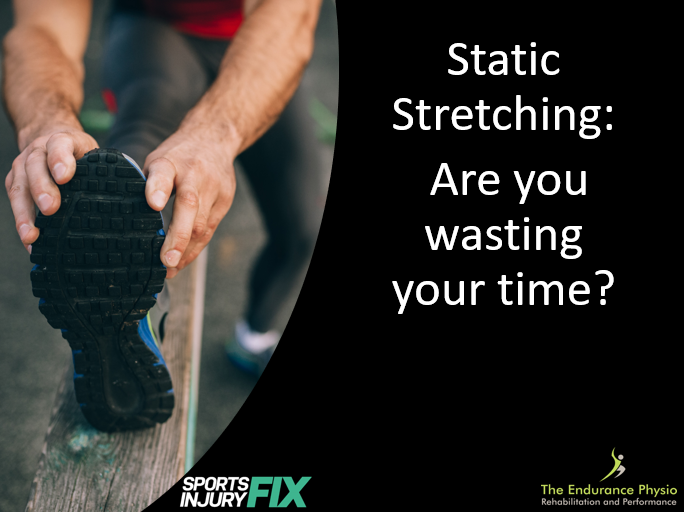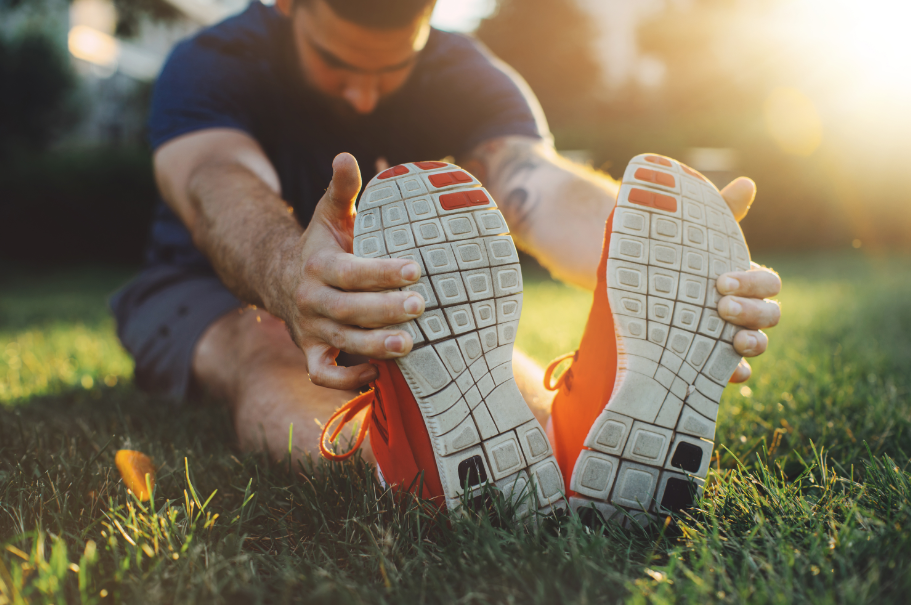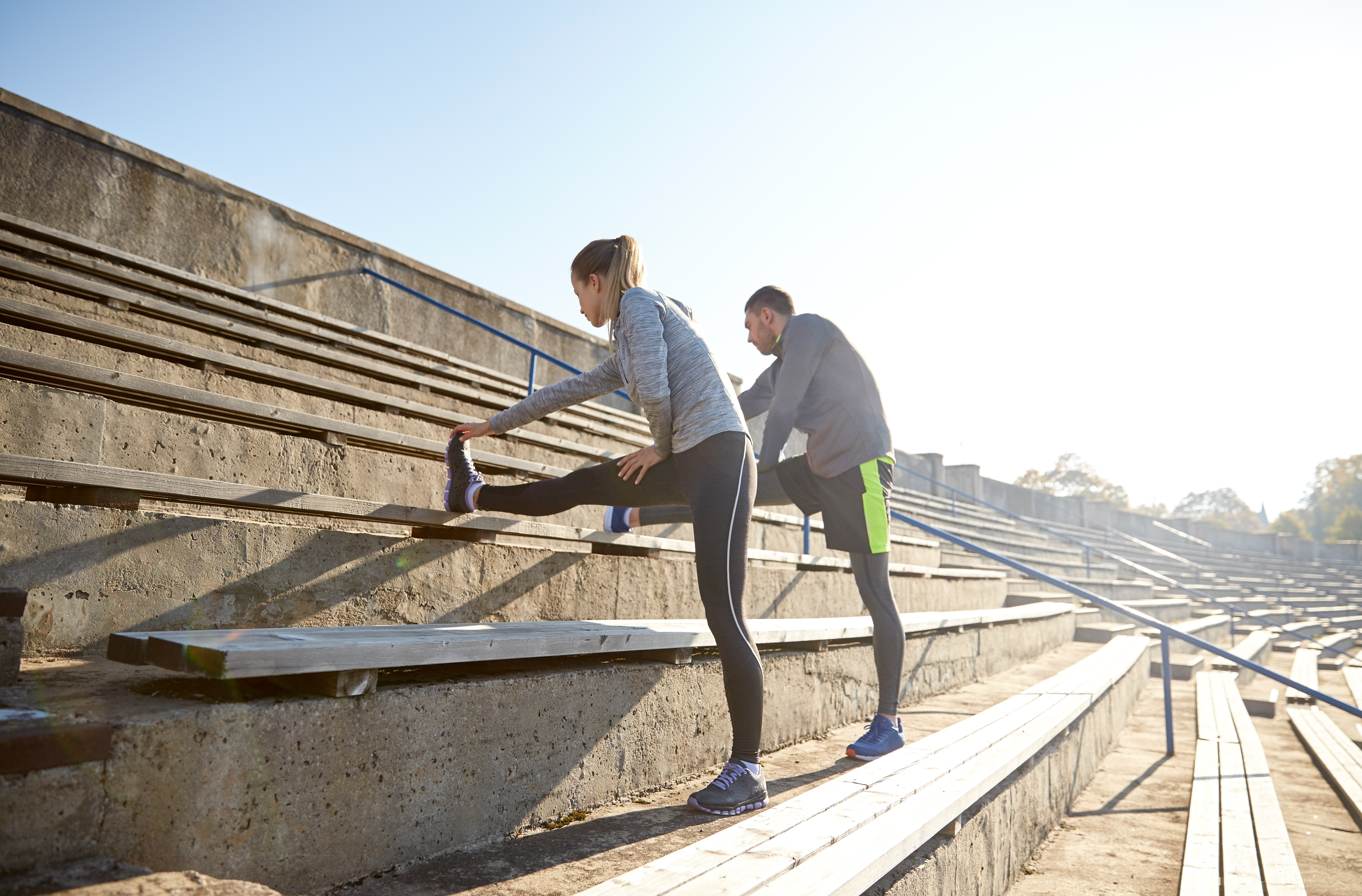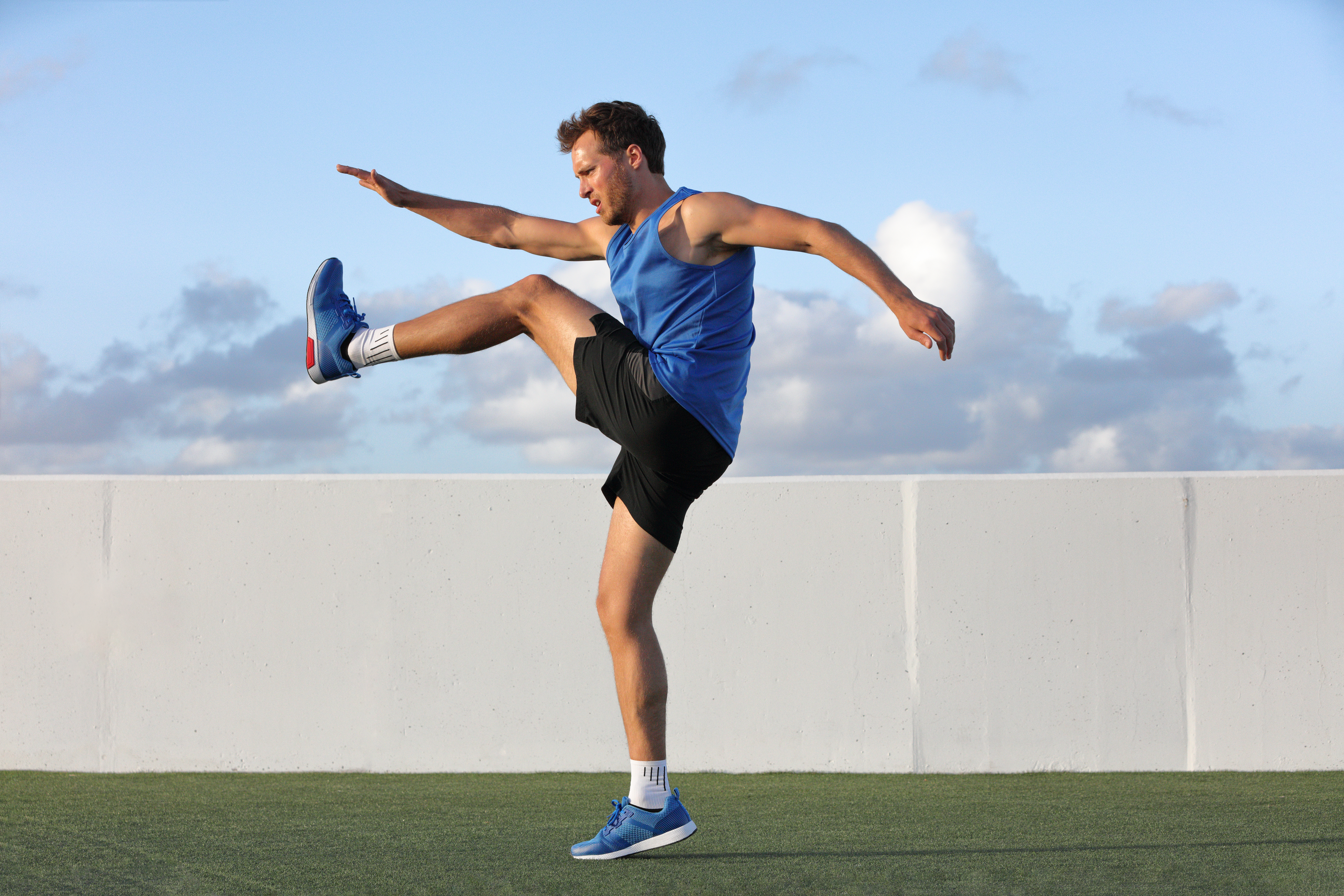Static Stretching: Are you wasting your time?
By Mike James | 13th June 2020 | General, Advice

Sports Injury Fix Director, and endurance specialist Physio Mike James (The Endurance Physio) has spent 25 years working with runners and endurance athletes. Recently he delivered a main stage talk at the National Running Show Digital event discussing the controversial and hotly debated topic of static stretching. He has turned it into a blog and asks the question: are you wasting your time doing it?
There is a battle raging.
A battle that I have been wielding my sword and shield in for many years.
A battle that I have fought with passion and aggression, sometimes seemingly getting closer to winning, others, seemingly almost on my knees in defeat. 
But what is this battle, surely it must be something worth fighting for? Something life or death?
Well…. nope……
It’s just good old static stretching and its proposed effects on performance, health and injury risk reduction.
In my role as "The Endurance Physio" I have had so many discussions, debates and downright arguments over the years that I have lost count.
Some were “wins” where I was able to change people’s beliefs and breakdown misconceptions, whilst others have quite frankly strengthened peoples counter opinions to my own and built bigger barriers than were already there.
Recently I have reconsidered my approach, I still maintain my passionate stance as an anti-stretcher, but I have decided to soften my message and lower my sword somewhat.
Why? Well quite frankly, the full-frontal attack isn’t working. Its time for a new approach, and that approach is to win hearts and minds.
Background
Since I entered the musculoskeletal world over 25 years ago, firstly as an exercise and fitness professional, then as a Sports Scientist, and most recently as a therapist, I have always had an uneasy relationship with static stretching.
In fact, this relationship has its roots as far back as 30 years ago, when as a young footballer and sportsman, the time spent during pre-exercise and game routines, that saw me holding various limbs and body parts in uncomfortable positions for prolonged periods of time always provided me with an opportunity to contemplate “what exactly is this actually doing?”.
I was also left wondering why more people weren’t questioning its use and why we all seemed to do it because its just what we do before exercise.
So as this battle has raged between those advocating for it, and those advocating against it, I stood firmly with the ranks of against and fought fire with fire trying to change and alter beliefs and the thinking surrounding it.

But I must confess, that deep down I could never quite explain exactly what it was that irked me so much.
On reflection, I think it was the unsubstantiated and bold claims made by those firm believers, disciples even, that so passionately made many believe you simply HAD to static stretch or you were:
1. Going to get injured
2. Under perform
3. Be inflexible and therefore limited in your activity potential
4. Fail to recover from exercise and activity
It was because of those that believed it was an elixir for many physical issues and would make an athlete bulletproof. Those that gave static stretching a seat at the top table of Sports and Exercise Medicine interventions (although thankfully this has started to be questioned at last.
As Paul Ingraham of PainScience.com writes in what I would state as the most up to date and thorough piece on stretching today, it is the “ritual” that many simply go through.
All made even more frustrating by the spotlight and attention given to many of these beliefs and claims by the mainstream media and magazines that so many of runners listen to.
I certainly got burned back in the pre-internet era when articles I wrote for nationally published magazines would be bastardised and my original work edited somewhat to reflect the message they wanted to push out.

My other issue was the outlandish and unproven narratives that supported these messages to reinforce the necessity to perform static stretching. Narratives including “breaking down adhesions”, “disrupting scar tissue”, “releasing tissues” or “lengthening muscle to improve posture” to name but a few. But these types of narratives are commonplace for many treatments within sports rehabilitation and musculoskeletal therapy.
And finally, as my career progressed into the rehabilitation and therapy world I was (and still am!) encountered multiple times on a daily basis with the comment “ I know the reason I’m injured is because I don’t stretch enough”, which was compounded further by the fact many of my peers fed this belief by prescribing stretches as the mainstay of their treatment!.
So, with that soap box moment being a good way to set the scene, its time for me to use my new approach – to be calm and considered in my “attack”.
Please do read on as I try to combine the evidence base, integrated with practicality and common sense mixed in to hopefully present the landscape regarding static stretching as it is today.
This article is written for the runner and athlete as part of my talk at the recent National Running Show Digital Event. Therefore, I have intentionally left the scientific references out. I don’t want to lose the simple message and hopeful thought provocation by simply listing reference and article after reference and article.
But please do get in touch if you want me to provide these for further reading or alternatively, the webinar is available on TherapistLearning.com.

To clarify - this article refers only to the act of STATIC STRETCHING - I am in favour as you'll see of many of the other methods claiming to develop flexibility - Yoga, flow type movements and similar practices hold more potential benefit in my eyes, although the narratives supporting some of these again remain questionable. But I feel they offer "more bang for your buck" in the limited time most of us have available around life, work and family.
Static stretching and Injury Prevention
The evidence base is pretty clear here – plenty of research has been done to prove there is little evidence in fact to support this. In fact, it is proposed that there lies a potential increased injury risk due to post stretch muscle activation, although no specific running studies can categorically support this to date.. That is not to say its definitively bad for you, but it simply doesn’t do what most people think.
It would be remiss of me to not say that some of the research isn’t of the highest quality in fairness.
Of note, we are seeing many professional sports and organisations retracting from static stretching. Probably the most notable being the Australian Ballet who have withdrawn static stretching from their dancer’s warm ups, and report no increase in injury ( Actually, a decrease in injury) and no decrease in performance. They have now opted to include strength training through joint range instead.
We see little evidence to support the notion that warm up static stretching reduces or prevents post exercise muscle soreness, yet a 5 minute internet search will find these claims being made time and time again.
Yes it may reduce the perception of tightness, and thats a good thing - potentially good enough to argue still doing it if you feel passionate enough to do so, but again, be aware that its the perception and not the biology / physiology that is the effect.
I find it hard to think of a common running practise that is more thoroughly dismissed by the available evidence. Yet I still see it – I see it everywhere and part of the blame must lie on the shoulders of many of the magazines and commercially interested parties within the running community (as well as the trainers, coaches and therapists) that continue to perpetuate the myth.
Static Stretching and general flexibility
Does the evidence suggest “tight” muscles can be lengthened and can we become more flexible?
Well actually yes. But here’s the question: what and why do we want to in runners?
The notion that flexibility is a pillar of fitness and well being is thankfully being challenged. The evidence doesn’t strongly indicate improvements in general health from simply performing stretches and increasing flexibility.
Maybe activities such as Yoga and Pilates actually involve strength work that include some element of “stretch” and can be more beneficial to health, but not in the way many people believe. Possibly because these activities provide us strength through range of movement.
I hear constantly that “I feel tight”, I don’t doubt the perception of tightness is real in runners, yet when I assess their muscle length – its normal, when I assess strength and capacity – it’s often lacking – I truly believe people who feel tightness in their running muscles, are not in fact tight, but are in fact fatigued muscles. Therefore a different approach is needed to address this, not static stretching.
We don’t even know how long or in which way we should stretch to increase flexibility at this time.
In truth the mechanism of effect may not be lengthening muscles at all, but more improving the tolerance of the stretch – it simply feels better and has less discomfort.
Probably a neurological effect or sensory adaptation at its upper limits is the essence of why it feels like you have more flexibility.

Stretching and performance
We are all looking to run faster, further and more effectively, and static stretching to assist this is deep rooted in the beliefs of much of the running community.
When we assess the evidence base, we see that not only does it not benefit performance, but in fact there is some evidence to suggest pre-exercise static stretching can reduce maximal power output and explosive power.
As a runner and coach myself, I certainly struggle to rationalise why I may want to do anything that might make it harder for me to run effectively after doing it?
I believe that in reality the opposite may be true - surely I want to be stiffer and stronger through the range that I need when I run?.
Even at my fastest speed am I / we working anywhere truly near our end range?
Probably not, so why chase that range?
Surely working on being strong, particularly through the ranges of movement and movement patterns that we will require during performance is a more sensible approach when trying to facilitate performance improvements?.
What else then?
Its all good and well saying static stretching is something we should probably be moving away from, but this blog would be pointless without offering an alternative.

Well when it comes to warming up, then we should probably be just concentrating on simply a graded progressive run approach.
Add in some dynamic drills and acceleration efforts and potentially some mobilisation drills that are excitatory in nature, not inhibitory.
The R.A.M.P. method has also become a popular approach to warm ups that to me holds a more structured and sensible approach than simply running for a bit and performing static stretches.
Whole body movements that actively move a joint or joint system plus its associated muscles through ranges without prolonged holds at endpoints should be part of a general warm up utilising the joints and muscle groups that are specific to runners.
Alternatively - just run for a bit longer before starting your effort run.
Outside of warm ups, maybe investigate Pilates, Yoga, Flow and other types of exercises that have the benefit of more bang for your buck when it comes to general and specific movement preparation.
Or even consider strength training with exercises such as deadlifts that lengthen muscles under load.
Take homes
The practical implications of this blog are that I still advocate that runners shouldn’t static stretch.
I continue to strongly resist the claim that static stretching reduces / prevents injury or improves general health and athletic performance in runners and endurance athletes of all abilities.
But I now advocate that if you really want to static stretch, if you feel it helps or even enjoy it, then please feel free to.
But just remember, it’s not doing what many still claim it does.
You aren’t improving performance; you aren’t reducing the risk of injury.
I wholeheartedly believe that static stretching can feel fantastic. But the truth is that its not anywhere as useful as many believe.
Is it a myth? No of course not, and that’s where I went wrong. Is it over-rated and exaggerated? – absolutely yes!
I feel that there are better things you could be doing with the limited time most of us with families, jobs and other commitments have. There are things you could alternatively be doing that can give you more bang for your buck. Concentrate on your overall training, your rest and recovery and bigger factors on performance and prevention such as sleep that have a much stronger evidence base to support them.
I will always continue to be frustrated when I see people making fundamental errors in their preparation and recovery but report “they do their stretches”.
And finally, to any coaches or therapists reading – please reconsider your messages if you have found this an uncomfortable read. The evidence base is readily available.
Thanks for reading.
